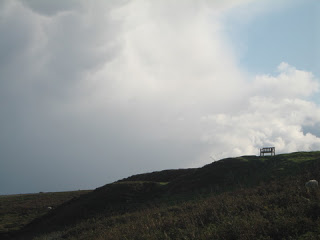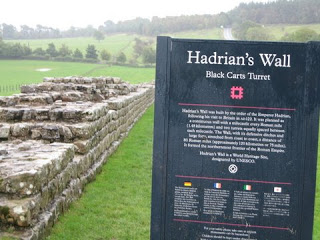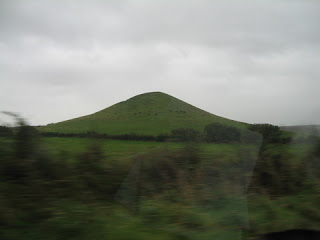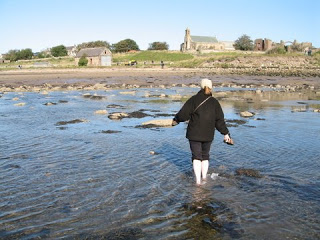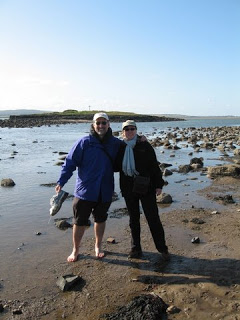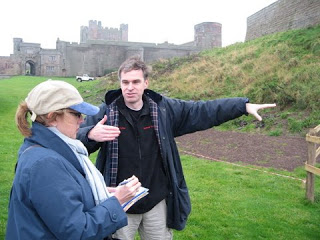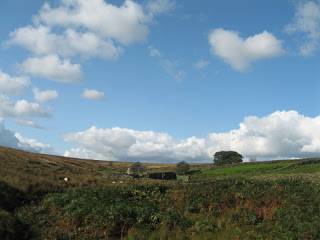Bamburgh, Yeavering and home again
The weight of the sky on the Yorkshire moors.
The ends of trips are, like any liminal states, difficult both to navigate and describe. There’s the physical stuff, of course – mounds of laundry, stacks of mail, all those must-do things that had been put aside for the trip, like washing the windows, getting the fireplace cleaned, writing the press releases for upcoming reading events, dealing with the wonky burglar alarm. And there’s the jet lag – strange dreams of unknown cities and waking up at odd hours, a vague nausea, an off-kilter appetite. But it’s the emotional weirdness that, for me, is the most disconcerting. It’s a sort of combined restlessness and grumpy fatigue, a desire to pull the covers over my head while feeling at the same time that if I don’t get EVERYTHING IN ORDER right now, somehow I’ll never catch up to myself.
So, small steps. Throw in the first load of laundry. Have a cup of coffee and a poached egg. Make the bed. Try and ignore the hideous news reports. (The video circulating of a McCain supporter holding a monkey doll with an OBAMA sticker wrapped round its head is enough to make me want to run back to the moors!)
Part of this liminal state is looking back at the somewhat frantic last few days of the “Anglo-Saxon Forced March Northwards” and attempting to put it into some kind of order.
The last place I wrote about being was Hartlepool, I think. From there we went to Jarrow, for a quick trip around Bede’s World, a wonderful site dedicated to The Venerable Bede, and a long drive through horizontal sheets of rain so that My Best Beloved could find Hadrian’s wall. We did pass an inordinate number of lovely stone walls, some of which I was quite sure would have contained at least some portion of the stones originally used on Hadrian’s wall, but no matter how frequently I pointed these out, My Best Beloved was not content until he found an actual part of the wall and stood upon it. The fact that this was accomplished by driving down a road clearly marked “Do not drive down this road” and which entailed a rather harrowing twenty minutes along a ridiculously narrow and occasionally flooded mud track, a 27 point turn and a face-to-face with another disgruntled motorist, in no way deterred my intrepid Best Beloved, bless ‘im.
Hadrian’s Wall — a brief selection
We also passed this interesting spot on the drive. It is a natural formation, not a great burial mound as I first suspected, and was sacred to the Anglo-Saxons. If memory serves, it was known as Frige’s Hill. (If I’m wrong about this, feel free to correct me.)
And so, at last, we found out way to Bamburgh and Budle Hall, the rather eccentric bed and breakfast where we lodged. Run by two very kind people, Sue and David, in a fabulous, if somewhat run-down late Georgian Manor, we were treated to fine art on the walls near the remarkable floating staircase, bright plastic ‘grass’ dividers on the breakfast table, stunning bouquets of fresh flowers on the mantle in our room, fairy-lights and Indian hippy-ish cloth on the mantles in the living room, bright green carpet and oranges walls, bathtubs in need of a good scrub, very loud opera music one night (and very loud Ab
ba music the next) combined with a television set tuned to the BBC (both courtesy of our hosts), no locks on any of the doors, and no numbers either (which led to an embarrassing moment when I couldn’t remember which room we were in and thus met a very nice couple who weren’t exactly expecting visitors), and an absurdly bucolic view of sheep and horses in the rolling fields, straight out of Jane Austen.
I haven’t quite made up my mind about the place. But doubtless it will feature in a short story sometime soon.
One of the first things we did was take advantage of a beautiful sunny day and head out to the Holy Island at Lindisfarne. This is where I learned about the importance of paying attention to tides. The only way to drive to Lindisfarne is over a causeway which, like that at St. Michel’s in France, is tidal. Low tide you’re clear. High tide you swim. So we dutifully checked the tide schedule and saw we were safe between 9:30 a.m. and 5:30 p.m. Loads of time.
Arriving at the island, we parked in the car park and wandered past the rows of picturesque cottages into the center of town where the ruins of the priory are. From there we visited the graveyard, naturally, and headed down to the shore. Lindisfarne was a monastery founded by St. Aidan, who came to the area from Iona at the request of King Oswald in the early 7th c. Both Aidan, and later Cuthbert lived on a tiny hermitage island which at low tide is accessible from Lindisfarne itself. Ron and I walked across the mussel-shell and sea-weed covered rocks to get to the tiny hermitage. The outline of a small stone hut survives, and is marked by a cross.
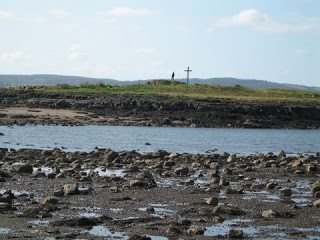 Lauren on the hermitage at Lindisfarne – that speck is me
Lauren on the hermitage at Lindisfarne – that speck is me
We sat on the rocky cliffs, watching the sun on the water. Far out on a sandbank, hundreds of seals basked, and from time to time their heads popped up quite near to shore. Three woman sat nearby, who had come to Lindisfarne on a retreat, and they sang songs in soft high voices, to the seals. We could have stayed for days. And nearly did.
After an hour or so, I stood up to stretch and further investigate the monk’s cells. This is when I noticed the rocky path we’d followed to get to the island had disappeared under a rapidly-deepening band of water. You’ll pardon the expression, but holy crap!
I called to Ron, and then to the three women, one of whom was probably in her seventies, and we headed for the water. There was nothing to it, but to take off our shoes and socks, roll up our pants and wade for the shore, and quickly. I noticed a coast guard jeep had arrived on the far shore, lights flashing, and that a small crowd had gathered, but no one seemed in the least inclined to wade over with a pair of Wellingtons. I set off first, and let me tell you, the water was icy cold and the mussel shells painfully sharp. My Best Beloved waited a few moments and at first I thought he was waiting to help the other ladies across, but then realized that although this may have been part of his plan, he was also waiting to get a good photo.
REALLY cold water and really sharp shells
I made it to shore, a little shaken and footsore, quickly put on my socks and shoes, and ran to the coast guard to ask if anyone had boots I could take back for the elderly lady. No lucks, although judging from the laughter this was apparently quite a funny question. The elderly lady, as it turns out, was extremely game and all thr
ee, and Ron made it back no worse for wear, and a little excited by the adventure. The coast guard’s job apparently, is to drive down to the island, laugh at the trapped tourists, smoke a cigarette, take our photo, and go home for tea. We found out that last year someone had spent nine hours trapped on the island. It seems the tide comes in here at least three hours than it does on the causeway – although this information isn’t marked anywhere. Consider yourself duly warned should you ever head for Lindisfarne. I will say, however, that the hour or so spent communing with the sea and the seals was worth the bruised, frozen feet.
safely on the right side of the tide (photo by the coast guard)
Bamburgh castle and the surrounding area are insanely atmospheric and it would be impossible not to write about it. In fact, I’m rather surprised everyone who lives there isn’t madly scribbling. From the brooding, still inhabited, castle on the cliffs at the edge of the sea, which dates back, it seems, to the Iron Age, to the nearby Cheviot hills, where another Iron Age fort once stood near Yeavering, a landscape dotted with Anglo-Saxon settlements, the entire place is alive with spirits and stories just straining to be told.
Bamburgh Castle at sunset with double rainbow
People could not have been more helpful. We met first with Graeme Young at Bamburgh castle. Graeme is the archaeologist there and he gave me any number of wonderful tidbits.
Graeme Young and Lauren at Bamburgh dig
When we’d finished up walking the ramparts and getting thoroughly soaked, Graeme invited Ron and me to join him and another archeologist, Kristian Pedersen, for lunch at the nearby Victoria Inn. Can’t tell you how welcome that cup of tea was. It also proved a most interesting couple of hours, as Kristian is an ex-paratrooper who served in Somalia and a man of considerable story himself – but they are his stories and not mine to tell.
On our final day before heading for Edinburgh, we went out to Yeavering, in the Cheviot Hills, the site of a great Anglo-Saxon palace, build in the shade of a huge dark hill on the top of which once stood the outline of an iron-age fortress. We met with Paul Frodsham, an archeologist who has written a number of books at the Red Lion Pub in nearby Wooler, and then drove the two or three miles to the place where King Edwin’s great compound one stood. You can learn more about this site here. The place was once called Ad Gefrin, which means At the Hill of the Goats, and although wild goats still live in the hills, and one actually came down to meet Paul one day, sadly none appeared for our visit.
Paul Frodsham and Lauren at Ad Gefrin
It may not look from this photo as though there was much to see, and that might be true, if one were looking for the sort of tourist attraction that generally leads people to such places. It was just the hills and the plain, and the River Glen below, where Paulinus once spent 36 days baptising new Christians. However, I was filled with a sense of peace there, and an undeniable resonance – the sort of feeling which invites you to find a warm rock next to a gurgling stream and sit down and listen to the voices of the land for a while. And that’s what I did, for not nearly long enough.
The truth is that part of my heart (as the song goes) remains on the windy, sky heavy, sea-tossed land of Northumberland. It is also true that nearly everything I thought I would write about before I went on this trip has changed. That is what you have to be ready for, if you decide to let a story lead you, rather than trying to force a tale into a preconceived shape.
Part of me, I must admit, is nervous about the new direction for this book. I feel it has to be much smaller, more intimate, and more human in scale than the historical epic I first envisioned. I also fear I will let down some people I spoke to on my journey who had very set ideas about the way saints and places should be handled. But the first responsibility of any writer, I feel, is to be true to the voice that speaks from their soul, if you will. In other words, I can only write the tale of the characters who introduce to themselves to me as I walk along the road to meet them.
Tomorrow I’ll sit again in front of a blank page and begin, for the fifth time, this novel of a woman in the Anglo-Saxon era of Northumberland. We’ll see where it all leads. . .
Copyright 2008 Lauren B. Davis For permissions: laurenbdavis.iCopyright.com
